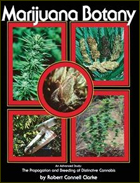
by Robert Connell Clarke
Peak Floral Stage
Elongation growth of the main floral stem ceases at this stage, and floral clusters gain most of their size through the addition of more calyxes along the secondary stems until they cover the primary stem tips in an overlapping spiral. Small reduced mono-leaflet and tri-leaflet leaves subtend each pair of calyxes emerging from secondary stems within the floral clusters. These subtending leaves are correctly referred to as bracts. Outer leaves begin to wilt and turn yellow as the pistillate plant reaches its reproductive peak. In the primordial calyxes the pistils have turned brown; however, all but the oldest of the flowers are fertile and the floral clusters are white with many pairs of ripe pistils. Resin secretion is quite advanced in some of the older infertile calyxes, and the young pistillate calyxes are rapidly producing capitate-stalked glandular trichomes to protect the precious unfertilized ovule. Under wild conditions the pistillate plant would be starting to form seeds and the cycle would be drawing to a close. When Cannabis is grown for sinsemilla floral production, the cycle is interrupted. Pistillate plants remain unfertilized and begin to produce capitate -stalked trichomes and accumulate resins in a last effort to remain viable. Since capitate-stalked trichomes now predominate, resin and THC production increase. The elevated resin heads appear clear, since fresh resin is still being secreted, often being produced in the cellular head of the trichome. At this time THC acid production is at a peak and CBD acid levels remain stable as the molecules are rapidly converted to THC acids, THC acid synthesis has not been active long enough for a high level of CBN acid to build up from the degradation of THC acid by light and heat. Terpene production is also nearing a peak and the floral clusters are beautifully aromatic. Many cultivators prefer to pick some of their strains during this stage in order to produce marijuana with a clear, cerebral, psychoactive effect. It is believed that, in peak floral clusters, the low levels of CBD and CBN allow the high level of THC to act without their sedative effects. Also, little polymerization of resins has occurred, so aromas and tastes are often less resinous and tar like than at later stages. Many strains, if they are harvested in the peak floral stage, lack the completely developed aroma, taste and psychoactive level that appear after curing. Cultivators wait longer for the resins to mature if a different taste and psychoactive effect is desired.
This is the point of optimum harvest for some strains, since most additional calyx growth has ceased. However, a subsequent flush of new calyx growth may occur and the plant continue ripening into the late floral stage.

